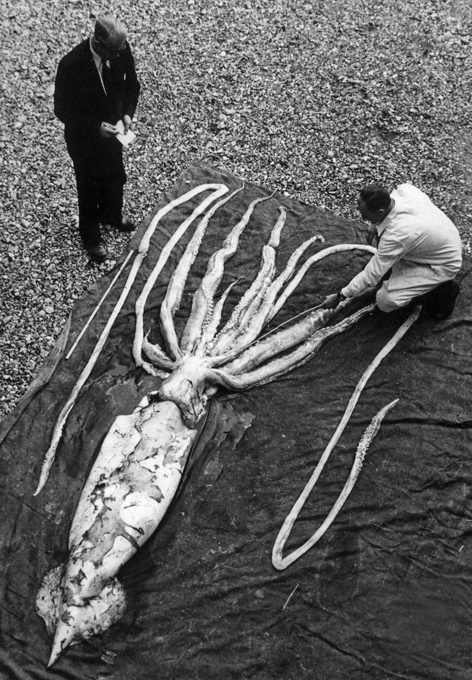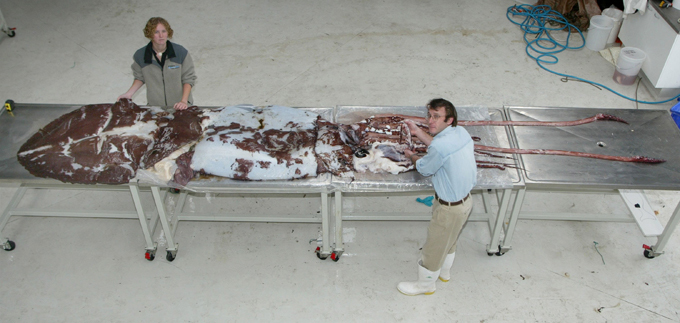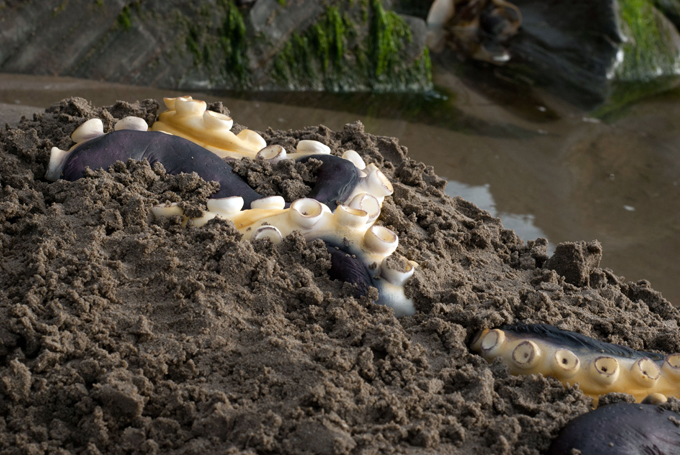What do we know of giant squid?

Giant squid can grow to a tremendous size due to deep-sea gigantism: recent estimates put the maximum size at 13 m (43 ft) for females and 10 m (33 ft) for males from the posterior fins to the tip of the two long tentacles (second only to the colossal squid at an estimated 14 m (46 ft),one of the largest living organisms)
Giant squid can grow to a tremendous size due to deep-sea gigantism: recent estimates put the maximum size at 13 m (43 ft) for females and 10 m (33 ft) for males from the posterior fins to the tip of the two long tentacles (second only to the colossal squid at an estimated 14 m (46 ft),one of the largest living organisms)

Claims of specimens measuring 20 m (66 ft) or more have not been scientifically documented.
Claims of specimens measuring 20 m (66 ft) or more have not been scientifically documented.

The number of different giant squid species has been debated, but recent genetic research suggests that only one species exists
The number of different giant squid species has been debated, but recent genetic research suggests that only one species exists

In 2004 Japanese researchers took the first images of a live giant squid in its natural habitat, and in July 2012 a live adult was first filmed in its natural habitat off Chichi-jima
In 2004 Japanese researchers took the first images of a live giant squid in its natural habitat, and in July 2012 a live adult was first filmed in its natural habitat off Chichi-jima

The elusive nature of the giant squid and its foreign appearance, often perceived as terrifying, have firmly established its place in the human imagination
The elusive nature of the giant squid and its foreign appearance, often perceived as terrifying, have firmly established its place in the human imagination

An unknown species of gigantic octopus has been hypothesised as a source of reports of sea monsters such as the lusca, kraken and akkorokamui as well as the source of some of the carcasses of unidentified origin known as globsters like the St. Augustine Monster.
An unknown species of gigantic octopus has been hypothesised as a source of reports of sea monsters such as the lusca, kraken and akkorokamui as well as the source of some of the carcasses of unidentified origin known as globsters like the St. Augustine Monster.

Representations of the giant squid have been known from early legends of the kraken through books such as Moby-Dick and Twenty Thousand Leagues Under the Sea on to novels such as Ian Fleming's Dr. No and Peter Benchley's Beast (adapted as a film called The Beast) and modern animated television programs.
Representations of the giant squid have been known from early legends of the kraken through books such as Moby-Dick and Twenty Thousand Leagues Under the Sea on to novels such as Ian Fleming's Dr. No and Peter Benchley's Beast (adapted as a film called The Beast) and modern animated television programs.

Giant squid are widespread, occurring in all of the world's oceans. They are usually found near continental and island slopes from the North Atlantic Ocean, especially Newfoundland, Norway, the northern British Isles, Spain and the oceanic islands of the Azores and Madeira, to the South Atlantic around southern Africa, the North Pacific around Japan, and the southwestern Pacific around New Zealand and Australia. Specimens are rare in tropical and polar latitudes
Giant squid are widespread, occurring in all of the world's oceans. They are usually found near continental and island slopes from the North Atlantic Ocean, especially Newfoundland, Norway, the northern British Isles, Spain and the oceanic islands of the Azores and Madeira, to the South Atlantic around southern Africa, the North Pacific around Japan, and the southwestern Pacific around New Zealand and Australia. Specimens are rare in tropical and polar latitudes



